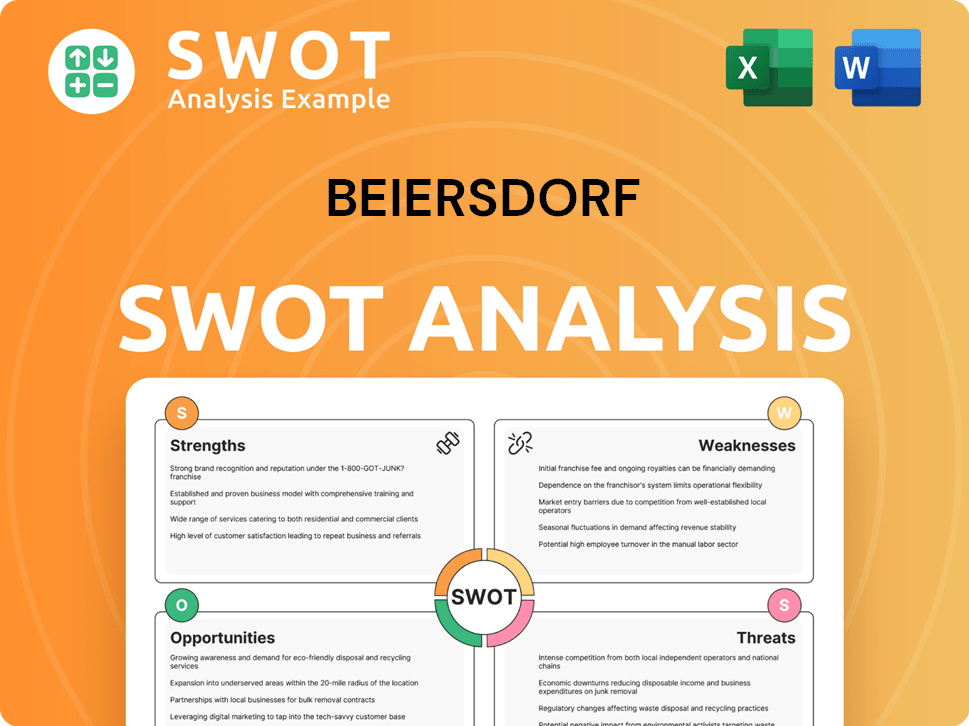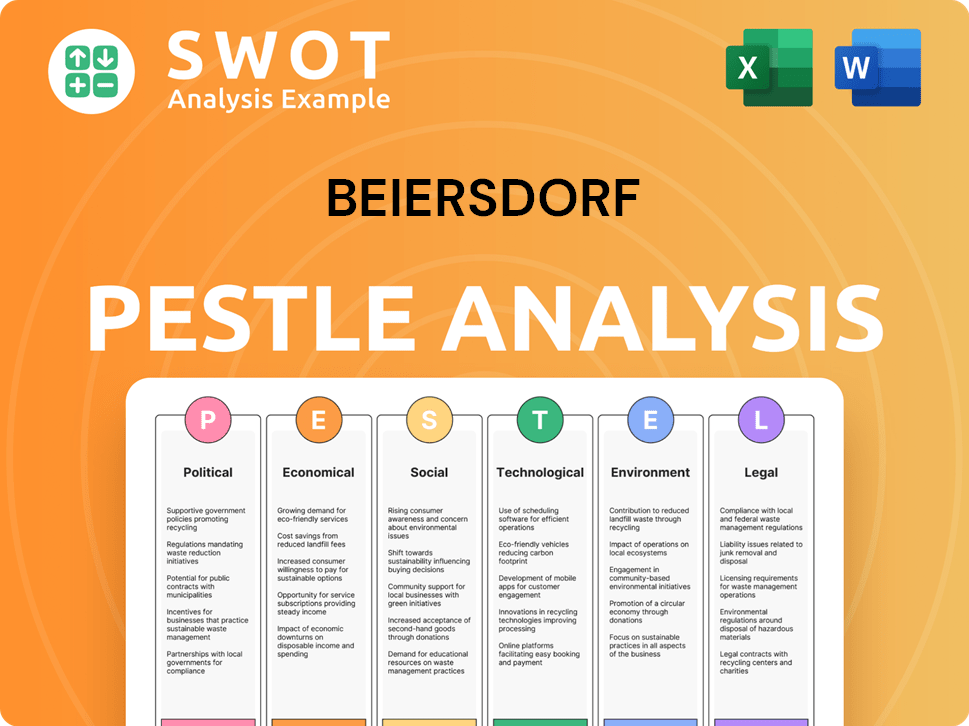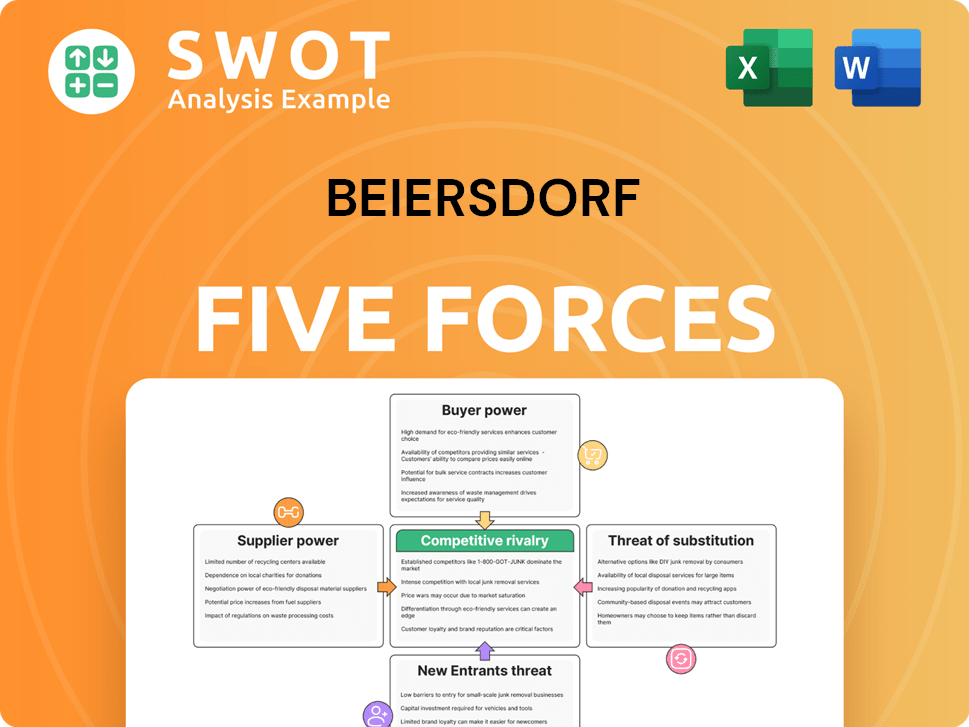Beiersdorf Bundle
Can Beiersdorf Maintain Its Skincare Dominance?
Beiersdorf AG, the Nivea parent company, stands as a titan in the global skincare industry, but what does the future hold for this iconic brand? Founded in 1882, Beiersdorf has consistently adapted, leveraging innovation to stay ahead in the competitive cosmetics market trends. This analysis dives deep into Beiersdorf's growth strategy and future prospects, offering a comprehensive look at its strategic initiatives.

From its humble beginnings to its current status, Beiersdorf's journey is a testament to strategic foresight. This exploration of Beiersdorf company analysis will examine its 'Win with Care' strategy, updated in 2024, and how it plans to navigate the skincare industry outlook. Discover the Beiersdorf SWOT Analysis, expansion plans in Asia, and the impact of inflation on sales. We'll also explore its sustainable product initiatives and strategies for digital marketing to understand how Beiersdorf aims to secure its long-term growth forecasts.
How Is Beiersdorf Expanding Its Reach?
The Target Market of Beiersdorf is expanding through strategic initiatives focused on entering new markets, launching innovative products, and strengthening distribution channels, particularly in e-commerce. A core aspect of their 'Win with Care' strategy is to be 'omnipresent for our consumers' by expanding product presence in strategic markets, categories, and segments. This approach is designed to capitalize on the evolving cosmetics market trends and skincare industry outlook.
In 2024, Beiersdorf significantly expanded its activities in key markets like India, China, and the United States. This expansion included launching various brands from its portfolio, such as Eucerin in India. The company is also actively developing 'white spaces' in skincare and expanding new sales opportunities, especially in e-commerce, which is a critical part of their Beiersdorf growth strategy.
Product pipeline expansion is also critical to Beiersdorf's future prospects. The company is cascading its breakthrough innovation, Epicelline, across its brands. This includes launches under Eucerin in 2024, Nivea starting in the second half of 2025, and La Prairie and Chantecaille in 2026. The company is also expanding the use of its patented anti-spot ingredient, Thiamidol, across its brand portfolio globally.
Beiersdorf is strategically entering new markets, with a focus on high-growth regions like India and China. This includes launching existing brands and adapting products to meet local consumer preferences. The company's expansion plans in Asia are a key driver of its growth strategy.
E-commerce is a significant focus, with Nivea's e-commerce sales in China increasing by 24% in Q1 2025. Beiersdorf is investing in digital marketing and adapting its strategies to enhance online presence. This approach is essential for navigating how Beiersdorf is adapting to e-commerce.
The company is rolling out innovative products, such as Epicelline and Thiamidol, across its brand portfolio. This includes launching new products and reformulating existing ones to meet changing consumer preferences. Beiersdorf's innovation in skincare products is a key aspect of its strategy.
Beiersdorf is also focusing on sustainability, with plans to relaunch its Nivea product line-up with improved formulas and more sustainable packaging in 2025. This aligns with the growing consumer demand for environmentally friendly products. This focus is part of Beiersdorf's sustainable product initiatives.
Beiersdorf's expansion initiatives include market entry, e-commerce growth, product innovation, and sustainability. These strategies are designed to drive long-term growth and adapt to market dynamics. The company's financial performance review reflects the impact of these strategies.
- Entering new markets like India and the US with existing brands.
- Boosting e-commerce sales, especially in China, with a 24% increase in Q1 2025.
- Launching innovative products like Epicelline and expanding Thiamidol across brands.
- Relaunching Nivea products with improved formulas and sustainable packaging in 2025.
Beiersdorf SWOT Analysis
- Complete SWOT Breakdown
- Fully Customizable
- Editable in Excel & Word
- Professional Formatting
- Investor-Ready Format

How Does Beiersdorf Invest in Innovation?
The commitment to innovation and technology is a cornerstone of the Beiersdorf growth strategy. This focus is deeply embedded in its corporate structure, driving its expansion and market leadership. The company's strategic initiatives are designed to capitalize on cosmetics market trends and the skincare industry outlook.
Beiersdorf consistently invests in research and development (R&D) to stay ahead in the competitive landscape. These investments fuel both internal advancements and collaborations with external innovators. This approach ensures the company can adapt to changing consumer preferences and maintain a strong position in the market.
Beiersdorf's 'Win with Care' strategy emphasizes its ambition to be the 'undisputed authority in skin care.' This is achieved through transformative innovations that address key consumer needs. The company's approach includes a strong emphasis on sustainable product initiatives and digital marketing strategies.
In 2024, Beiersdorf's R&D investment reached €354 million, a 10.4% increase from the previous year. This significant investment underscores the company's commitment to innovation.
Beiersdorf is concentrating on three key future areas: hyperpigmentation, aging skin, and acne. These areas represent significant opportunities for growth and innovation.
The patented active ingredient, Thiamidol, is a significant growth driver, particularly in addressing hyperpigmentation. Its use is expanding across the brand portfolio.
The Nivea Luminous630 range, featuring Thiamidol, achieved 34% organic growth in 2024. This demonstrates the effectiveness of the innovation.
Beiersdorf leverages its expertise in epigenetics for anti-aging solutions. The company has invested over 15 years in epigenetic research.
The first epigenetic skincare product, Eucerin Hyaluron-Filler Epigenetic Serum, was launched in September 2024. This innovation will be cascaded across other brands.
Digital transformation and sustainability are key strategic pillars for Beiersdorf. The company is utilizing digital tools and data analytics to gain consumer insights and adapt to evolving trends, including e-commerce.
- Beiersdorf is advancing eco-conscious packaging solutions, aiming for 100% recyclable or reusable packaging by 2025.
- A new production center in Leipzig-Seehausen represents a nearly €300 million investment.
- The new production center aims to reduce CO2e emissions by approximately 58% within its value chain.
- Beiersdorf's production plants in the EU are targeted to be climate-neutral by January 2025, with a global target for all production sites by 2030.
- For more details, you can read about the Owners & Shareholders of Beiersdorf.
Beiersdorf PESTLE Analysis
- Covers All 6 PESTLE Categories
- No Research Needed – Save Hours of Work
- Built by Experts, Trusted by Consultants
- Instant Download, Ready to Use
- 100% Editable, Fully Customizable

What Is Beiersdorf’s Growth Forecast?
The financial outlook for Beiersdorf is positive, supported by its 'Win with Care' strategy. The company demonstrated robust financial performance in 2024, achieving record net sales and significant organic growth across its business segments. This strong foundation sets the stage for continued expansion and market leadership within the cosmetics market trends and skincare industry outlook.
In 2024, Beiersdorf's net sales reached €9.9 billion, reflecting a 6.5% organic sales growth. The Consumer Business Segment was a key driver, exceeding €8 billion in net sales with a 7.5% organic increase. The operating result (EBIT), excluding special factors, rose to €1.37 billion, resulting in an improved EBIT margin of 13.9%. This financial performance underscores the effectiveness of Beiersdorf's strategies and its ability to navigate a competitive landscape.
Looking ahead, Beiersdorf anticipates sustained profitable growth. For fiscal year 2025, the company projects a Group organic sales growth in the range of 4-6%. The Consumer Business Segment is also expected to grow organically by 4-6%. Furthermore, the consolidated EBIT margin (excluding special factors) is forecasted to be slightly higher than the previous year's level, indicating continued financial health and efficiency.
In Q1 2025, Beiersdorf reported group sales of €2.7 billion, achieving an organic growth of 3.6%. The Consumer Business Segment generated €2.3 billion in sales, with organic growth of 2.3%.
The Derma business saw a significant organic sales growth of 11.4% in Q1 2025, demonstrating strong performance and market demand. This growth highlights the effectiveness of Beiersdorf's focus on the skincare industry outlook.
Nivea's organic sales grew by 2.5% in Q1 2025, despite a strong comparison base from Q1 2024 and strategic repositioning in China. This highlights the resilience of the Nivea brand.
Beiersdorf aims for an EBIT margin expansion of 50 basis points per year in the Consumer Business Segment, indicating a focus on improving profitability and operational efficiency.
Beiersdorf's strategic initiatives, including a further share buyback program valued at up to €500 million in 2025, following a successful program in 2024, demonstrate its commitment to enhancing shareholder value. These financial strategies, coupled with the company's focus on innovation and market expansion, position Beiersdorf favorably for future growth. For a detailed analysis of the competitive environment, consider exploring the Competitors Landscape of Beiersdorf.
Beiersdorf Business Model Canvas
- Complete 9-Block Business Model Canvas
- Effortlessly Communicate Your Business Strategy
- Investor-Ready BMC Format
- 100% Editable and Customizable
- Clear and Structured Layout

What Risks Could Slow Beiersdorf’s Growth?
The Beiersdorf growth strategy faces several challenges that could affect its future. These risks include market competition, geopolitical instability, supply chain issues, and technological disruptions. Understanding these obstacles is crucial for assessing the Beiersdorf future prospects and the company's overall performance.
The company must navigate a complex landscape of market dynamics and operational hurdles. The Beiersdorf company analysis reveals a need to proactively manage these challenges to sustain its growth trajectory. This proactive approach is vital for maintaining its position in the cosmetics market trends and the broader skincare industry outlook.
Several factors could hinder Beiersdorf's expansion plans in Asia and elsewhere. These include market competition, economic volatility, and the need for continuous innovation. For a deeper dive into their marketing approach, consider reading about the Marketing Strategy of Beiersdorf.
Intense competition is a constant challenge for Beiersdorf. This includes pricing disputes with retailers and aggressive attacks on brands and products by rivals. The company must also protect its trademarks and product claims to maintain its market position.
Geopolitical instability and macroeconomic volatility significantly impact Beiersdorf. The luxury market slowdown in China, coupled with inventory reductions in the U.S. and travel retail, has affected sales. For example, the La Prairie brand saw a 17.5% sales decline in Q1 2025.
Supply chain issues and rising procurement costs for raw materials and packaging negatively affect profitability. These factors require careful management to mitigate their impact on the Consumer business. Addressing these vulnerabilities is crucial for maintaining profit margins.
Technological advancements, particularly in AI, present challenges. These relate to data feeding to external models and the use of their output. Beiersdorf is revising its R&D technology strategy to adapt to the rapidly evolving technological landscape.
Recruiting and retaining suitable talent, along with providing comprehensive training on new technologies, remains a challenge. This is especially true for tasks with a strong digital component. Beiersdorf addresses this through its employer branding program.
Beiersdorf is actively addressing these risks through various strategies. These include refocusing its Nivea business in China on premium products, skincare, and e-commerce. The company also conducts comprehensive risk reviews, adjusting definitions, and updating assessments of probability and impact.
Inflation can significantly affect Beiersdorf's sales by increasing production costs and potentially reducing consumer spending. This requires strategies to manage pricing and maintain market share. The company must carefully monitor economic indicators and adjust its strategies accordingly.
Beiersdorf employs digital marketing to reach consumers through e-commerce, social media, and targeted advertising. These strategies are key for adapting to changing consumer preferences and competing effectively. The company has been investing in digital platforms to enhance brand visibility.
Beiersdorf Porter's Five Forces Analysis
- Covers All 5 Competitive Forces in Detail
- Structured for Consultants, Students, and Founders
- 100% Editable in Microsoft Word & Excel
- Instant Digital Download – Use Immediately
- Compatible with Mac & PC – Fully Unlocked

Related Blogs
- What are Mission Vision & Core Values of Beiersdorf Company?
- What is Competitive Landscape of Beiersdorf Company?
- How Does Beiersdorf Company Work?
- What is Sales and Marketing Strategy of Beiersdorf Company?
- What is Brief History of Beiersdorf Company?
- Who Owns Beiersdorf Company?
- What is Customer Demographics and Target Market of Beiersdorf Company?
Disclaimer
All information, articles, and product details provided on this website are for general informational and educational purposes only. We do not claim any ownership over, nor do we intend to infringe upon, any trademarks, copyrights, logos, brand names, or other intellectual property mentioned or depicted on this site. Such intellectual property remains the property of its respective owners, and any references here are made solely for identification or informational purposes, without implying any affiliation, endorsement, or partnership.
We make no representations or warranties, express or implied, regarding the accuracy, completeness, or suitability of any content or products presented. Nothing on this website should be construed as legal, tax, investment, financial, medical, or other professional advice. In addition, no part of this site—including articles or product references—constitutes a solicitation, recommendation, endorsement, advertisement, or offer to buy or sell any securities, franchises, or other financial instruments, particularly in jurisdictions where such activity would be unlawful.
All content is of a general nature and may not address the specific circumstances of any individual or entity. It is not a substitute for professional advice or services. Any actions you take based on the information provided here are strictly at your own risk. You accept full responsibility for any decisions or outcomes arising from your use of this website and agree to release us from any liability in connection with your use of, or reliance upon, the content or products found herein.